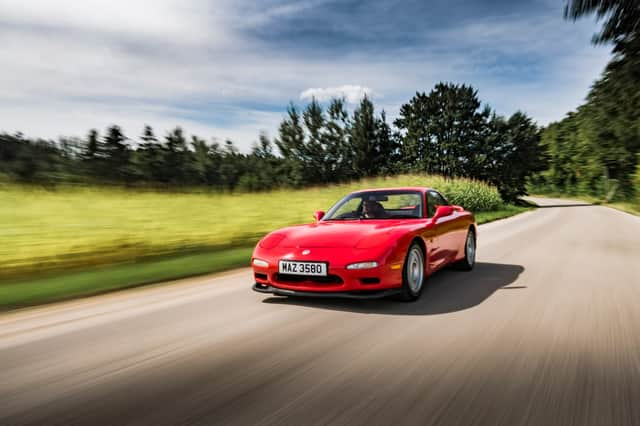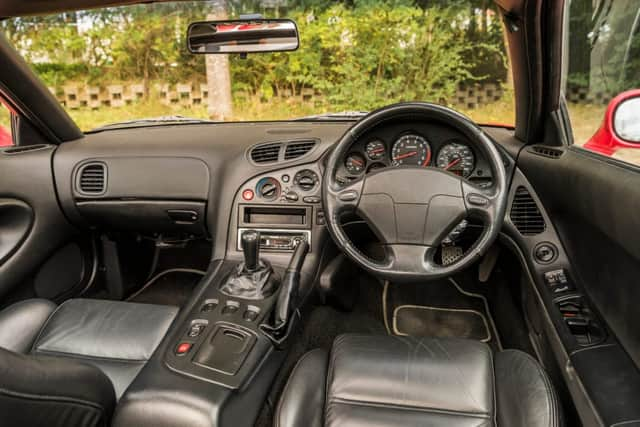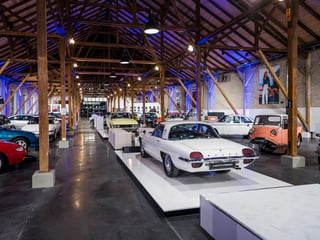Retro rides: 1994 Mazda RX-7


Anyone who has played a Gran Turismo game or watched a Fast and Furious film should be familiar with the RX-7. Its sleek looks, rear-drive chassis and unusual powertrain have made it a favourite among virtual and real-life racers and tuners around the world.
People have done crazy things with the third-generation FD3 variant, from coating it in outrageous bodykits and paintjobs to doubling its rotor count and forcing 1,200bhp to a custom-made all-wheel drive setup.
Advertisement
Hide AdAdvertisement
Hide AdHowever, we’re sticking with the unadulterated original today. A 1994 model with the beautiful bodywork unmolested and its twin-turbo, two-rotor engine putting out a regular 237bhp or so via a five-speed manual gearbox.
Even before you fire up that quirky engine, the RX-7 is a thing of wonder. A quarter of a century after it first appeared it’s still stunning to look at with simple flowing curves, an understated front splitter and rear spoiler, and pop-up headlights, which, we all know, are cool. Despite a subtly muscular appearance that gives it road presence, the FD3 is actually shorter and narrower than the current Mazda 3 hatchback and a mere 123cm tall.


1994 Mazda RX-7
- Price when new: £25,000
- Engine: 1.3-litre, twin-rotor, twin-turbo petrol
- Power: 237bhp
- Torque: 218lb ft
- Transmission: Five-speed manual
- Top speed: 156mph
- 0-60mph: 5.4 seconds
Of course, the RX-7’s defining feature isn’t the way it looks but what powers it. Mazda is famous for being the only car brand to persevere with Felix Wankel’s rotary engine concept. Using a triangular rotor to create a radial combustion process rather than a linear one via regular pistons is a peculiar and notoriously fragile way to generate power but Mazda has done wonders with it, using various one-, two- and three-rotor iterations in everything from family saloons to Le Man-winning racers.
In the RX-7 the setup and two turbos allow for a 1.3-litre engine to produce a healthy 237bhp, enough to get it to 60mph in just 5.4 seconds back in 1994. This example probably isn’t that quick now but it still feels plenty rapid enough and the astonishingly linear way it delivers the power is just as important as the pace. Despite the two turbos, there’s no lag here, just a straight smooth run towards the red line, snicking through the tight five-speed ‘box accompanied by an utterly unique fizzing, buzzing engine note that encourages you to use every single last revolution.
Advertisement
Hide AdAdvertisement
Hide AdI drove the RX-7 shortly after its diminutive cousin the MX-5 and stepping into the larger coupe straight after the tiny roadster is a slightly strange experience. For a minute or two it feels big and heavy and unresponsive, then you retune your senses to forget that ridiculously agile tiny thing and you realise that the RX-7 is still light by modern standards and the steering still sharp, direct and communicative.
Like the little MX-5 there’s a weight and feel that no electronically assisted rack can truly replicate and that means you can carve through the countryside with a real connection. It flows seamlessly along twisting back roads with a poise and suppleness that might surprise drivers of more modern fare. Despite its control and accuracy, the RX-7 isn’t sprung with a chiropractor’s bank balance in mind but with a pliancy that delivers immense grip and a comfortable ride. You could easily cruise all day listening to that unique engine and revelling in its easy pace.


You’d also be stuck “revelling” in its mid-90s interior. It’s a bit of a cliche to be cruel about old Japanese interiors but they really are pretty ropey. For a start there’s not a huge amount of space and you feel penned in by the low roof and high centre console. Then there are the materials. Okay, this press car is 26 years old and has lived a hard life but everywhere you turn the plastic is brittle and so shiny you can see your reflection in it, and the switchgear rattles in its mounts.
That’s hardly a fault unique to the Mazda, pretty much every Japanese sports car of the era was similarly afflicted but, like them, you’re quickly distracted from your immediate surroundings by the thrill of hearing that rotary motor buzzsaw its way towards the red line and threading its the long bonnet along the next stretch of twisting Tarmac.
Advertisement
Hide AdAdvertisement
Hide AdSome old sports cars lose their charm in the modern world - what was impressive a couple of decades ago feels less so now. But the RX-7 isn’t one of those. It looks as wonderful as ever and is as poised and engaging , if not more so, than many modern motors.
